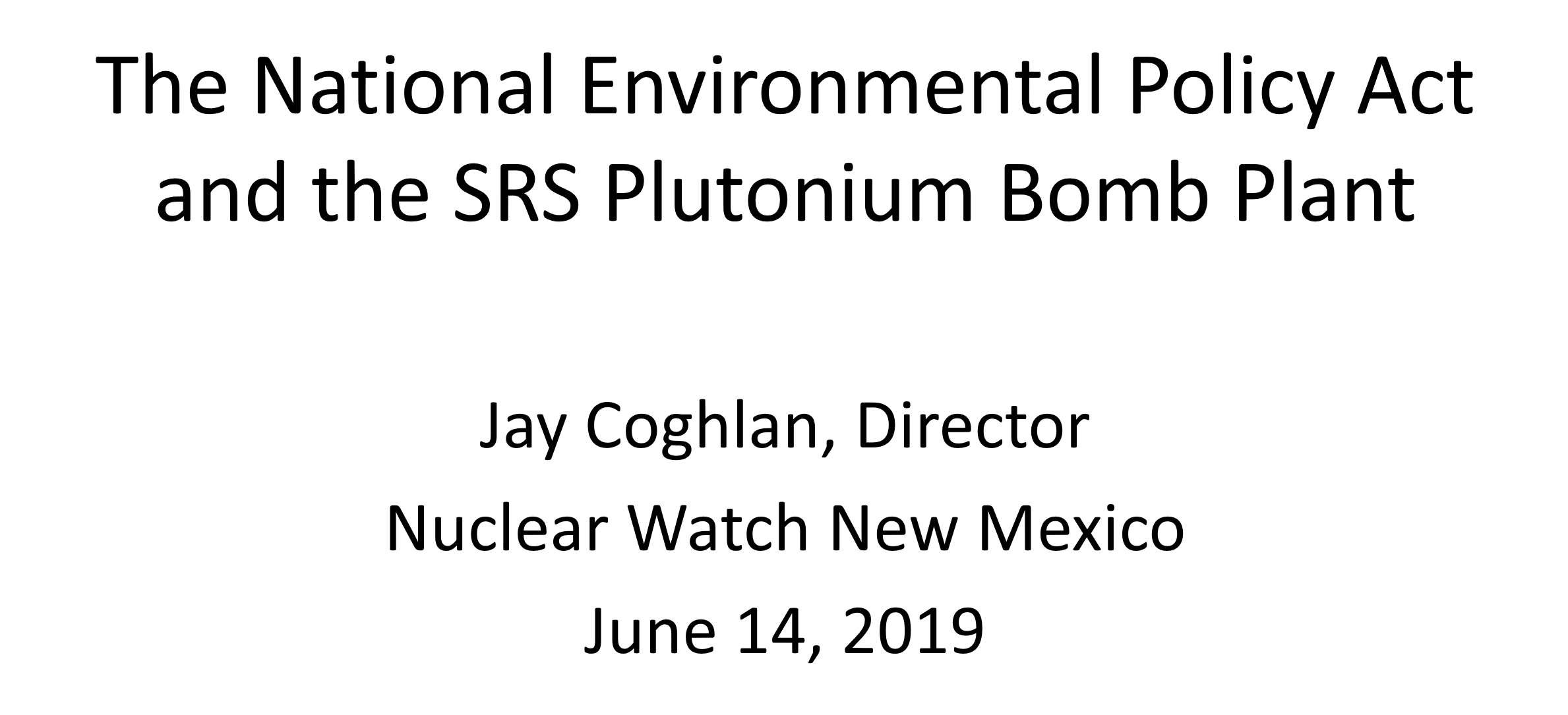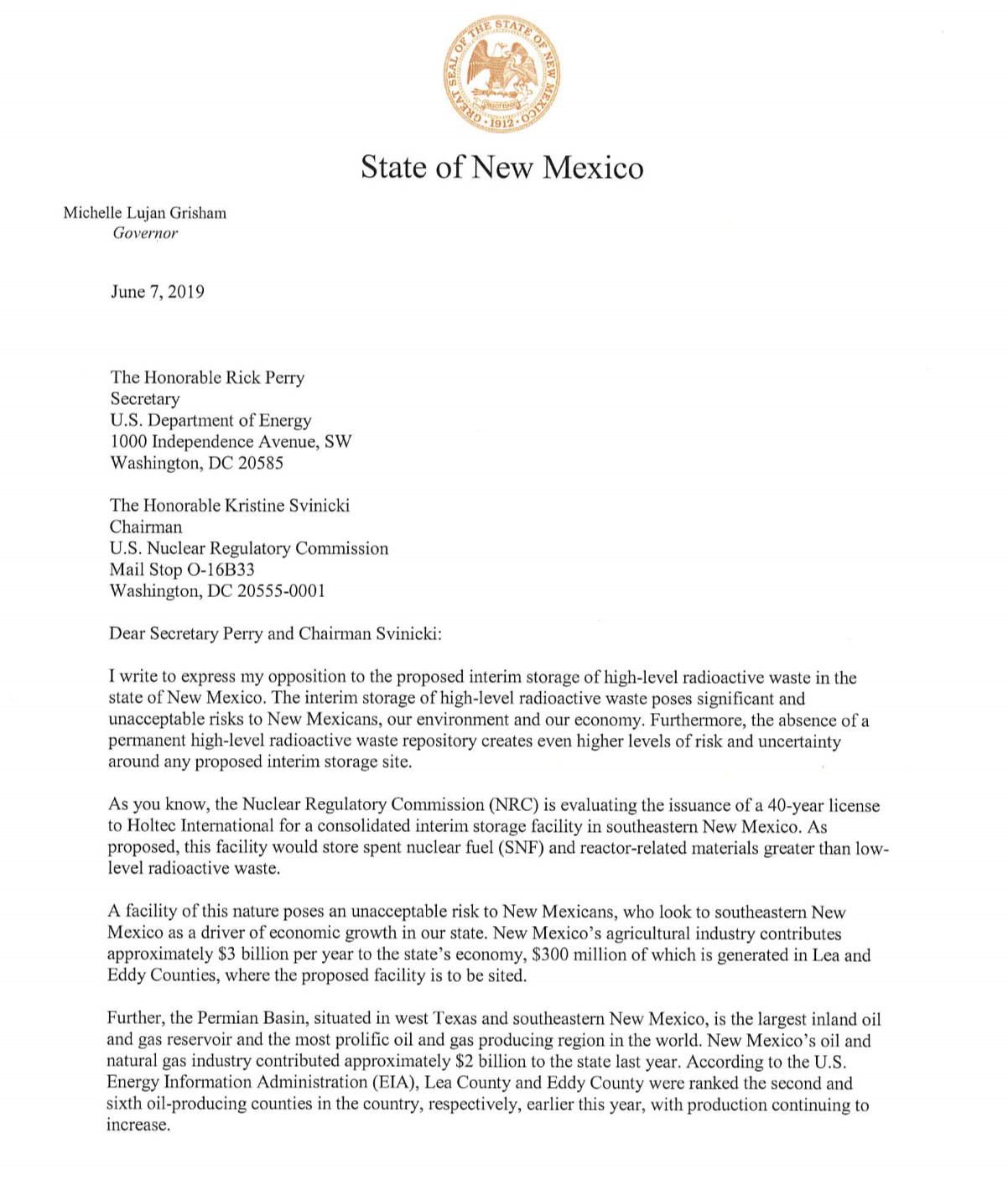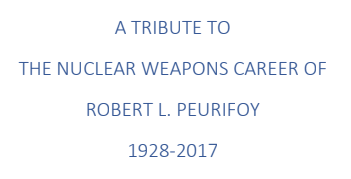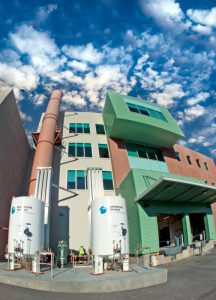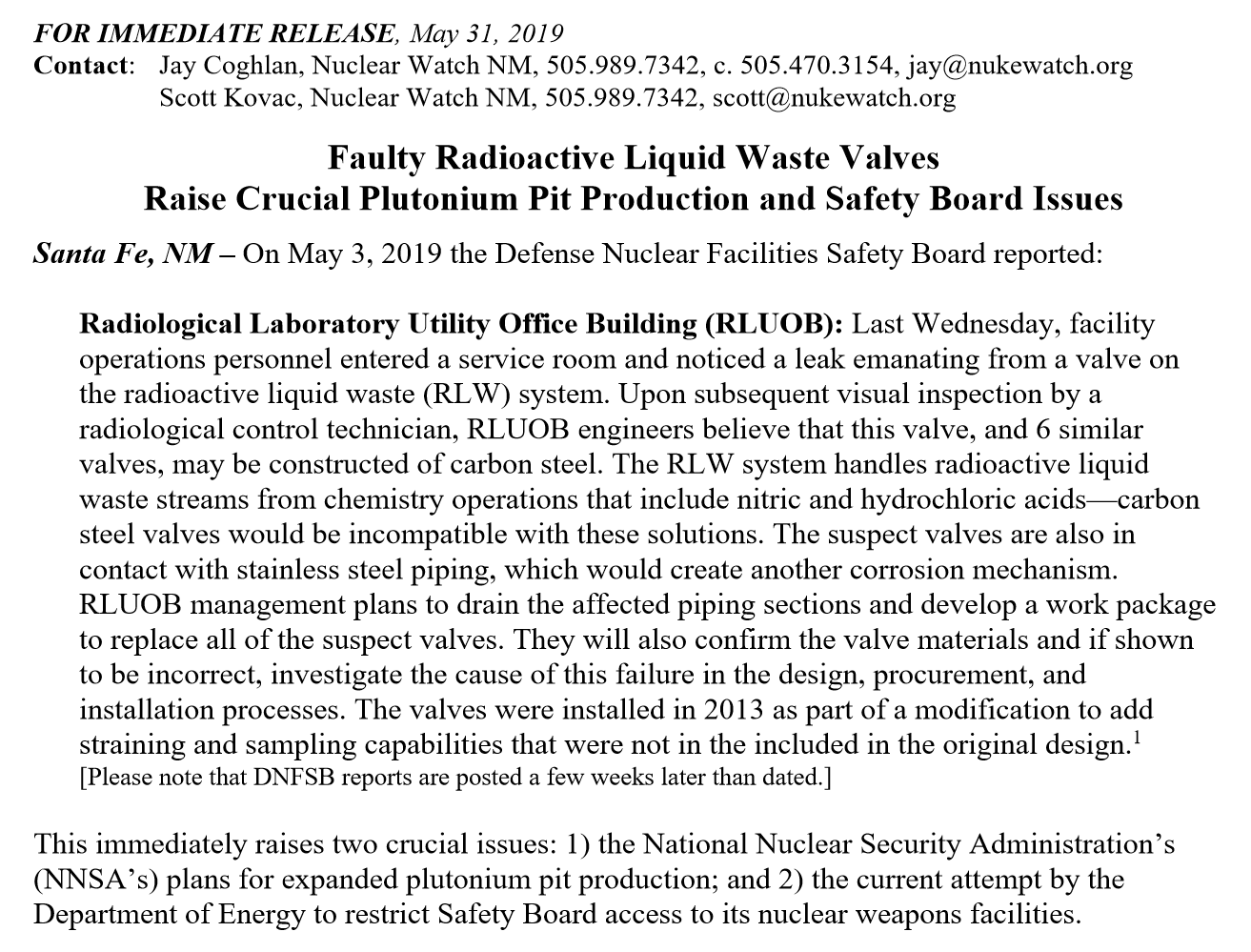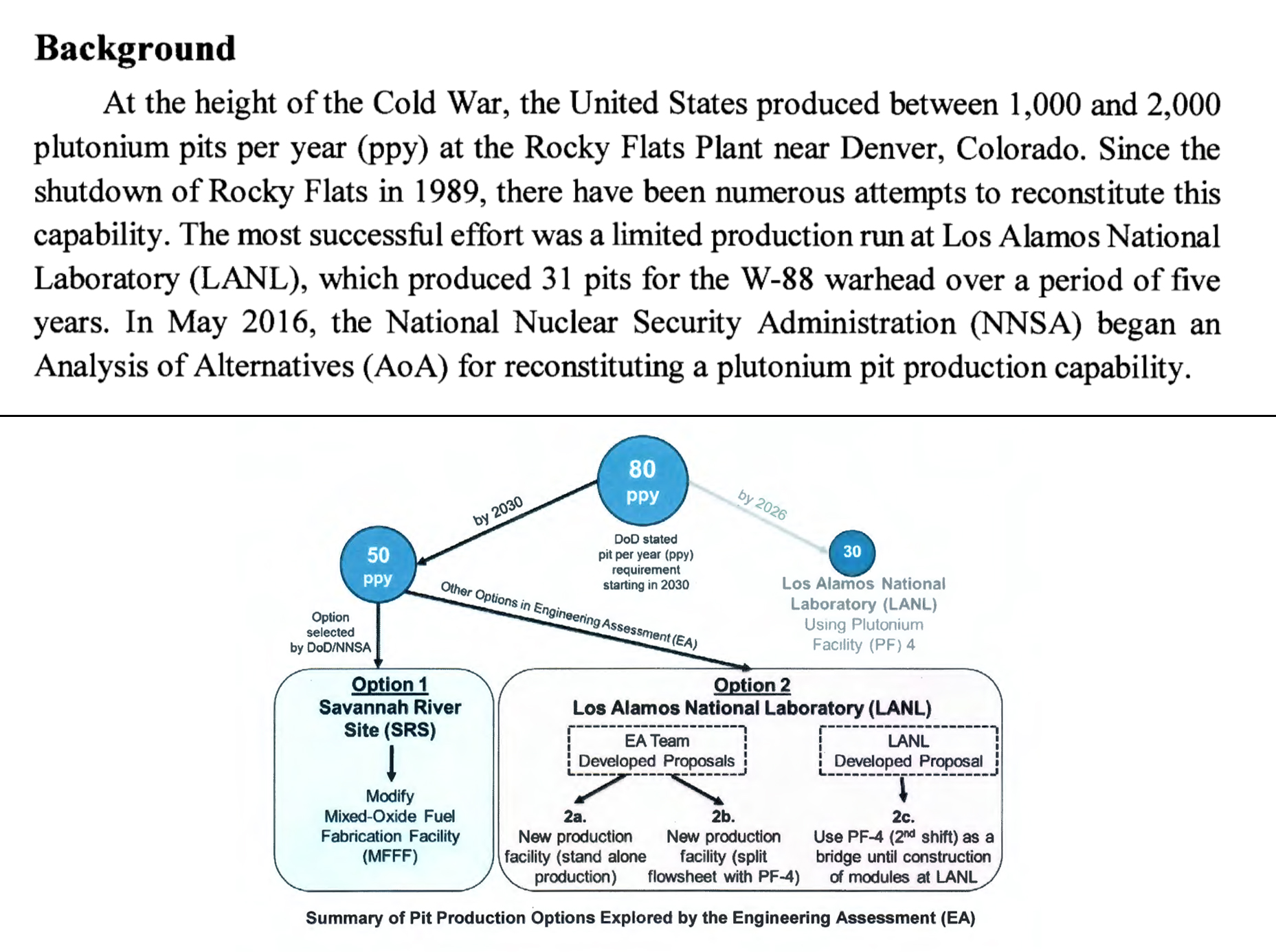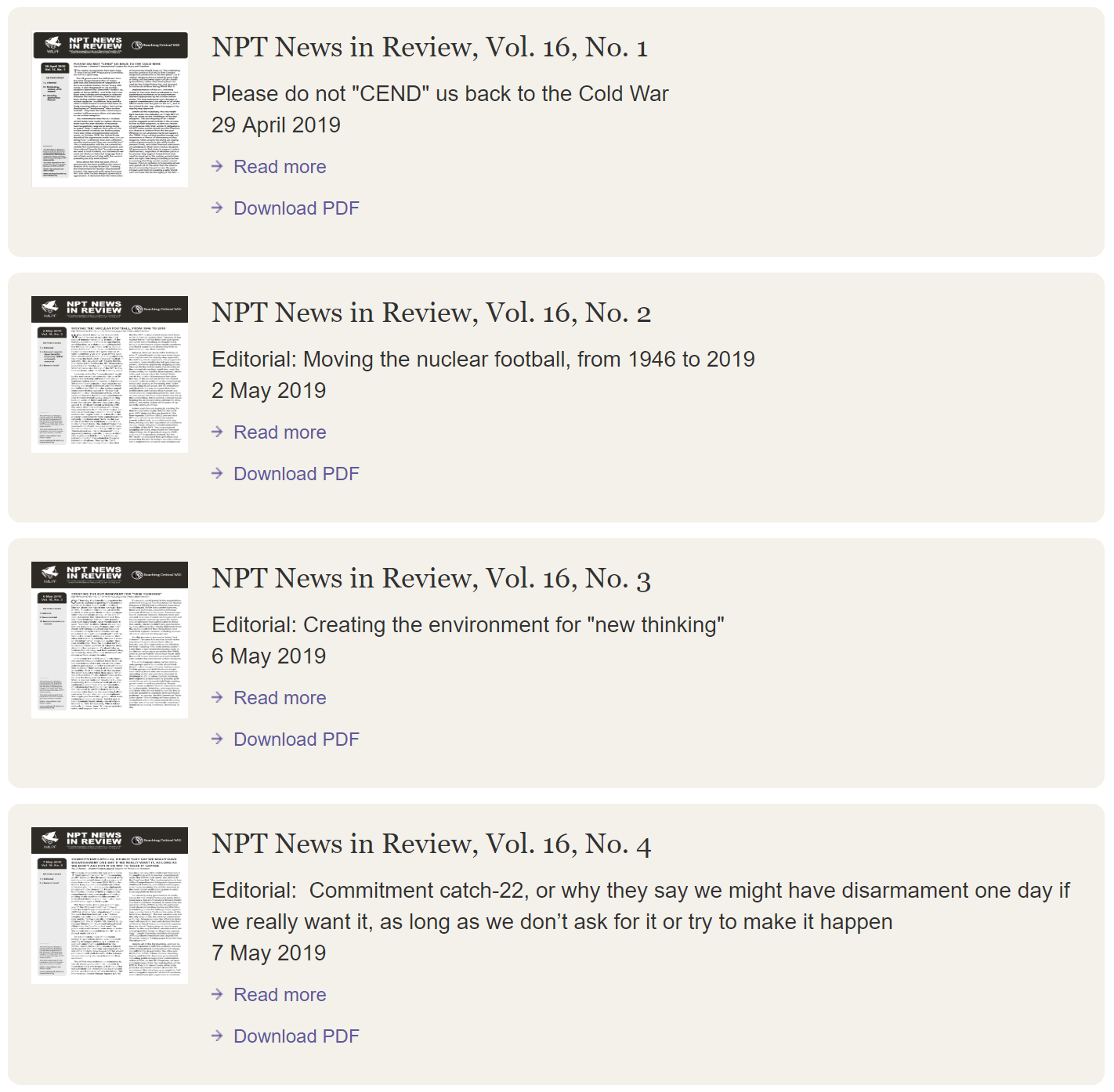2023 News Articles – All Posts
Nothing Found
It seems we can’t find what you’re looking for. Perhaps searching can help.
2022 Select Highlighted Press Items
Nuclear Modernization is the ’Absolute Minimum,’ STRATCOM Commander Says | March 8, 2022
US tested hypersonic missile in mid-March but kept it quiet to avoid escalating tensions with Russia | April 4, 2022
Putin’s Nuclear Threats Are a Wake-Up Call for the World | March 15, 2022
Intelligence report determines that Russia's WMD threats will grow as losses mount in Ukraine | March 19, 2022
China and the United States: It’s a Cold War, but don’t panic | March 10, 2022
Russian military doctrine calls a limited nuclear strike “de-escalation.” Here’s why. | March 8, 2022
North Korea says it will strike with nuclear weapons if South attacks | April 4, 2022
Flying Under The Radar: A Missile Accident in South Asia | April 4, 2022
2022 News Articles
[embeddoc url=”https://nukewatch.org/wp-content/uploads/2019/06/SRS-plutonium-bomb-plant6-14-19.pptx” download=”all” viewer=”microsoft”]
Forum addresses plutonium pit expansion at SRS
BY SARAH LEBLANC | augustachronicle.com
AIKEN — A forum regarding the Department of Energy’s proposed expanded production of plutonium pits at Savannah River Site was held Friday evening.
About 70 people gathered in the auditorium of the Aiken Municipal Building to hear speakers present information against the proposal and encourage the public to write to their representatives in opposition to the plan.
The Department of Energy has proposed to use the former Mixed Oxide Fuel Fabrication Facility as the location to produce about 50 plutonium pits per year. The pits make up the radioactive cores of nuclear weapons.
Tom Clements, director of Savannah River Site Watch, said the department should not rush into a new project at the MOX plant, which was shut down in October.
Critics raise concerns over proposed atomic bomb factory near Aiken
Anti-nuclear activists fired away Friday at what they said is a dangerous and little known plan to produce deadly atomic weapons components at the Savannah River Site near Aiken.
BY SAMMY FRETWELL | thestate.com
The federal government has proposed a multibillion dollar plutonium pit factory that could create as many as 1,700 jobs as part of an effort to make fresh plutonium, a major ingredient in atomic bombs.
But the proposed factory is raising concerns about its risk to the environment and the public, in addition to how it would be viewed by world leaders. Critics say the government may use the pits in a new type of nuclear weapon, instead of only replenishing the existing stockpile with fresh plutonium.
Savannah River Site Watch, a nuclear watchdog organization that tracks SRS, held a public meeting Friday night in Aiken County to brief people on the government’s plan at SRS, a 310-square-mile complex in western South Carolina.
“We don’t think people are really aware of what is going on: that this new mission is fraught with risk that could come to SRS,’’ Savannah River Site Watch director Tom Clements told The State.
Nuclear watchdog groups from New Mexico and California joined SRS Watch for the forum in Aiken County, where many SRS workers live. Before the Friday meeting, the groups held a news conference to voice concerns. The U.S. Department of Energy plans its own forum on the proposal June 27 in North Augusta.
Critics raise concerns over proposed atomic bomb factory near Aiken
Anti-nuclear activists fired away Friday at what they said is a dangerous and little known plan to produce deadly atomic weapons components at the Savannah River Site near Aiken.
JUNE 14, 2019 | BY SAMMY FRETWELL | thestate.com
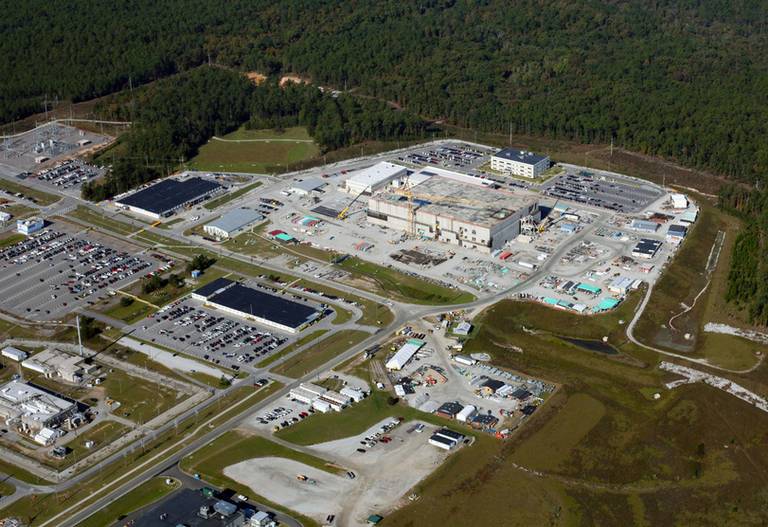
The federal government has proposed a multibillion dollar plutonium pit factory that could create as many as 1,700 jobs as part of an effort to make fresh plutonium, a major ingredient in atomic bombs.
Pro-nuclear groups say the pit plant is a good replacement for the mixed oxide fuel facility, commonly known as MOX. Not only will it provide jobs, but it will help keep the United States safe, they say.
Clements and Jay Coghlan, who directs Nuclear Watch New Mexico, don’t see it that way.
“It will be a great waste of taxpayer’s money,’’ Coghlan said. “There also is a long history of chronic safety problems and environmental or waste problems associated with pit production.’’
The proposed factory is raising concerns about its risk to the environment and the public, in addition to how it would be viewed by world leaders. Critics say the government may use the pits in a new type of nuclear weapon, instead of only replenishing the existing stockpile with fresh plutonium.
LETTER: New Mexico governor says no to high-level nuclear waste
mynorthwest.com June 7, 2019
ALBUQUERQUE, N.M. (AP) — New Mexico’s governor said Friday she’s opposed to plans by a New Jersey-based company to build a multibillion-dollar facility in her state to temporarily store spent nuclear fuel from commercial reactors around the U.S.
In a letter to U.S. Energy Secretary Rick Perry, Gov. Michelle Lujan Grisham said the interim storage of high-level radioactive waste poses significant and unacceptable risks to residents, the environment and the region’s economy.
She cited the ongoing oil boom in the Permian Basin, which spans parts of southeastern New Mexico and West Texas, as well as million-dollar agricultural interests that help drive the state’s economy.
Any disruption of agricultural or oil and gas activities as a result of a perceived or actual incident would be catastrophic, she said, adding that such a project could discourage future investment in the area.
“Establishing an interim storage facility in this region would be economic malpractice,” she wrote.
Holtec International has defended its plans, citing unmet obligations by the federal government to find a permanent solution for dealing with the tons of waste building up at nuclear power plants.
 The latest episode of Ploughshares Fund’s new podcast, Press the Button, features Donté Stallworth — former NFL wide receiver and now national security wonk.
The latest episode of Ploughshares Fund’s new podcast, Press the Button, features Donté Stallworth — former NFL wide receiver and now national security wonk.
Hear his remarkable analysis of rising tensions with Iran, Trump’s flaws, and his ideas for a saner nuclear policy: https://www.ploughshares.org/pressthebutton
Listen and subscribe on iTunes · Spotify · SoundCloud · Google Play
Halting Holtec – A Challenge for Nuclear Safety Advocates
The loading of 3.6 million pounds of highly radioactive spent nuclear fuel has been indefinitely halted at the San Onofre independent spent fuel storage installation (ISFSI), operated by Southern California Edison and designed by Holtec International.
BY JAMES HEDDLE | counterpunch.org
Last month, the Nuclear Regulatory Commission (NRC) fined Southern California Edison an unprecedented $116,000 for failing to report the near drop of an 54 ton canister of radioactive waste, and is delaying giving the go-ahead to further loading operations until serious questions raised by the incident have been resolved.
Critics have long been pointing out that locating a dump for tons of waste, lethal for millions of years, in a densely populated area, adjacent to I-5 and the LA-to-San Diego rail corridor, just above a popular surfing beach, in an earthquake and tsunami zone, inches above the water table, and yards from the rising sea doesn’t seem to make a lot of sense from a public safety standpoint.
The near drop incident last August, revealed by a whistleblower, has drawn further attention to the many defects in the Holtec-designed and manufactured facility. It has been discovered that the stainless steel canisters, only five-eights inches thick, are being damaged as they are lowered into the site’s concrete silos. Experts have warned that the scratching or gouging that is occurring makes the thin-walled canisters even more susceptible to corrosion-induced cracking in the salty sea air, risking release of their deadly contents into the environment and even of hydrogen explosions.
Furthermore, critics point out, these thin-walled canisters are welded shut and cannot be inspected, maintained, monitored or repaired.
How Trump Could Restart the Nuclear Arms Race
Some key arms control agreements could be on the chopping block.
BY FRED KAPLAN | slate.com
If President Donald Trump doesn’t act quickly, the nuclear arms race, which has been fairly dormant for decades, might break into a gallop.
Trump is famously hostile toward international treaties, especially those that constrain America’s actions, even if they’re actions that no one is particularly keen to take. The Iran nuclear deal, the Paris climate agreement, the Trans-Pacific Partnership, and the Intermediate-Range Nuclear Forces Treaty are all commitments that Trump has ripped up for no good reason.
The scuttling of that last accord, often abbreviated as the INF Treaty, which was signed in 1987 by U.S. President Ronald Reagan and Soviet Union leader Mikhail Gorbachev (and eliminated all U.S. and Soviet missiles having a range between 500 and 5,000 kilometers), marked the first time Trump abrogated a nuclear arms agreement between the United States and Russia, the two major nuclear powers.
Bob Peurifoy worked at the Sandia Labs for 39 years, serving as director of nuclear weapon development and retiring as a vice president. He was the driving force behind many safety improvements to U.S. nuclear weapons and a strong believer in conservative maintenance of the stockpile. Bob was also a strong critic of aggressive Life Extension Programs that further diverged the stockpile from its tested pedigree and wasted taxpayers’ money. As Bob’s friend and colleague Gordon Moe puts it, “Bob’s family and I hope that Bob’s wisdom and reason as reflected in the Tribute will continue to benefit humanity for many more years through its use as a reference by researchers in the field of nuclear weaponry.”
VIEW FULL TRIBUTE – PDF
Nation’s most ambitious project to clean up nuclear weapons waste has stalled at Hanford
The Energy Department’s most environmentally important and technically ambitious project to clean up Cold War nuclear weapons waste has stalled, putting at jeopardy an already long-delayed effort to protect the Columbia River in central Washington.
BY RALPH VARTABEDIAN | latimes.com
Entry sign at Hanford Site, Washington.Photograph taken by Tobin Fricke – January 2005.
In a terse letter last week, state officials said the environmental project is at risk of violating key federal court orders that established deadlines after past ones were repeatedly missed.
Two multibillion-dollar industrial facilities intended to turn highly radioactive sludge into solid glass at the Hanford nuclear site have been essentially mothballed. Construction was halted in 2012 because of design flaws and Energy Department managers have foundered in finding alternatives, according to the letter that threatens new litigation.
The department has stored 56 million gallons of radioactive sludge left over from the production of plutonium in 177 leaky underground tanks on a desert plateau a few miles from the Columbia River, raising concerns that the material has migrated into groundwater and eventually will reach the largest river in the West.
 Listen to the latest episode of Ploughshares Fund’s new podcast, Press the Button, featuring Eric Schlosser, filmmaker and author of several publications, including Command and Control. This is a particularly powerful episode to share. Eric is clear and compelling about the inherent risks of our deterrence strategy, the fallibility of the US nuclear command and control and the horrors from the use of just one nuclear weapon. He is one of the most compelling advocates on our issues in the country today. It’s worth a listen!
Listen to the latest episode of Ploughshares Fund’s new podcast, Press the Button, featuring Eric Schlosser, filmmaker and author of several publications, including Command and Control. This is a particularly powerful episode to share. Eric is clear and compelling about the inherent risks of our deterrence strategy, the fallibility of the US nuclear command and control and the horrors from the use of just one nuclear weapon. He is one of the most compelling advocates on our issues in the country today. It’s worth a listen!
You can listen here: https://www.ploughshares.org/pressthebutton
Or – Listen and subscribe on iTunes · Spotify · SoundCloud · Google Play
HASC Panel’s Bill Could Slow-Roll NNSA’s Planned S.C. Pit Plant
The Department of Energy would no longer have to make 80 plutonium pits a year by the end of the next decade, if legislation unveiled Monday in the Democrat-controlled House becomes law.
EXCHANGE MONITOR | June 4, 2019
The legislation, due for a vote Tuesday by House Armed Services strategic forces subcommittee “would repeal the requirement for the Secretary of Energy to demonstrate the capability to produce war reserve plutonium pits at a rate sufficient to produce 80 pits per year by 2027,” according to the subcommittee’s portion of the 2020 National Defense Authorization Act (NDAA).
The NDAA is the annual policy bill that sets funding limits for defense programs including those managed by the DOE’s National Nuclear Security Administration (NNSA). The full House Armed Services Committee is set to vote on the entire House NDAA on June 12.
New, More Usable Nukes for Trump? No.
Congress should use the new defense authorization bill to bar the deployment of new, dangerous, and redundant nuclear weapons.
REP. TED W. LIEU D-CALIFORNIA & SEN. EDWARD J. MARKEY D-MASSACHUSETTS | defenseone.com
U.S. NAVY / MASS COMMUNICATION SPECIALIST 1ST CLASS JAMES KIMBER |The Ohio-class ballistic missile submarine USS Tennessee (SSBN 734) returns to Naval Submarine Base Kings Bay.
The United States has the world’s most powerful military ever. It spends more on defense than the next seven countries combined and has developed many of the most destructive conventional weapons ever created to ensure that America can address any threat. Congress consistently authorizes investments in innovative technology and weaponry to protect our country and our allies. We also possess a strong nuclear deterrent.
These are insanely destructive weapons with an unparalleled ability to kill and destroy, both instantly and for years afterward from the nuclear fallout. Nuclear weapons should never, ever be used first and new nuclear weapons must not be designed to be more usable.
Yet last year, the Trump Administration came to Congress with just such a request to develop a new “low-yield” nuclear warhead for our submarine-launched ballistic missile, the Trident D5. Congress foolishly authorized the development of this warhead on a party-line vote, but there is still time to correct course.
Letter on Need for a Programmatic EIS for Expanded Plutonium Pit Production
Could Trump Trash The Nuclear Test Ban Treaty?
Think of what the world would be like if Russia, the United States, China, India and Pakistan were testing nuclear weapons.
BY MICHAEL KREPON | forbes.com
They are not because of the Comprehensive Test Ban Treaty (CTBT) which is responsible for shutting down nuclear testing by major and regional powers for more than two decades. Walking away from the CTBT would be extraordinarily dumb and dangerous, but the Trump administration has taken a step in this direction.
The CTBT was negotiated in 1996, but it isn’t solidly in place. While Russia has signed and ratified it, Senate Republicans rejected it in 1999. China, like the United States, has signed but not ratified. There are other holdouts, including India and Pakistan. And yet none of these states has tested nuclear weapons since 1998. When a treaty is negotiated, it’s common diplomatic practice not to undercut its objectives while awaiting its entry into force. Hence the two-decades-long moratorium on testing by every nuclear-armed state except North Korea.
Billion-dollar LANL building has plumbing problem
BY MARK OSWALD / JOURNAL STAFF WRITER
Saturday, June 1st, 2019 at 12:05am Copyright © 2019 Albuquerque Journal
SANTA FE – A building at Los Alamos National Laboratory with a price pegged at more than $1 billion apparently has some bad plumbing.
A federal safety oversight board recently reported that the operations staff at the Radiological Laboratory Utility Office Building found a leak in the building’s radioactive liquid waste system.
…
Jay Coghlan of Nuclear Watch New Mexico, a frequent LANL critic who called attention to the recent safety board report, said the plumbing problem is symptomatic of the lab’s history of safety issues, which has included using the wrong kind of cat litter as a desiccant when packing a radioactive waste drum. A reaction in the drum caused it to breach in 2014 and contaminate the nation’s nuclear waste storage facility near Carlsbad.
30th Anniversary of Tiananmen Square
Thirty years ago, Beijing’s Tiananmen Square became the focus for large-scale protests, which were crushed by China’s Communist rulers.
In the 1980s, China was going through huge changes. The ruling Communist Party began to allow some private companies and foreign investment. Leader Deng Xiaoping hoped to boost the economy and raise living standards. However, the move brought with it corruption, while at the same time raising hopes for greater political openness. The Communist Party was divided between those urging more rapid change and hardliners wanting to maintain strict state control. In the mid-1980s, student-led protests started, and in spring 1989, the protests grew, with demands for greater political freedom. On June 4, 1989, Chinese troops were sent to crush pro-democracy student protests in the famous square in central Beijing, leaving at least hundreds—and possibly thousands—of people dead.
The casualties included soldiers, but were overwhelmingly unarmed demonstrators who had been protesting in the square for six weeks, turning the site into the hub for protests in 400 other cities nationwide. Millions of people took part in the demonstrations, with more than 1 million people descending on Tiananmen Square.
As part of an ongoing brutal crackdown of internal dissent, Chinese authorities have carried out a harsh policy of history suppression, forbidding on-line or other discussions of the events at Tiananmen Square. In light of that it is worth recalling what U.S. government officials learned at the time and how they assessed Beijing’s response to internal dissent.
To mark an event that decisively shaped contemporary China, the National Security Archive is republishing three documentary E-books that appeared on previous anniversaries, in 1999, 2001, and 2015. The declassified documents demonstrate that U.S. embassy officials realized very quickly that the Chinese military had carried out a massacre ordered by top officials who feared the public expression of dissent could threaten Communist Party rule. VIEW HERE
Billion-dollar LANL building has plumbing problem
JUNE 1, 2019 | BY MARK OSWALD | abqjournal.com
Copyright © 2019 Albuquerque Journal
SANTA FE – A building at Los Alamos National Laboratory with a price pegged at more than $1 billion apparently has some bad plumbing.
A federal safety oversight board recently reported that the operations staff at the Radiological Laboratory Utility Office Building found a leak in the building’s radioactive liquid waste system.
Lab watchdogs have labeled RLUOB, which got the green light for construction in 2011, as the most expensive building in New Mexico. The lab’s website says it’s part of a capital project to replace aging Cold War-era facilities.
Jay Coghlan of Nuclear Watch New Mexico, a frequent LANL critic who called attention to the recent safety board report, said the plumbing problem is symptomatic of the lab’s history of safety issues, which has included using the wrong kind of cat litter as a desiccant when packing a radioactive waste drum. A reaction in the drum caused it to breach in 2014 and contaminate the nation’s nuclear waste storage facility near Carlsbad.
“Remember, this is the gang that couldn’t get it straight between organic and inorganic cat litter, sending a radioactive waste drum that ruptured and closed the Waste Isolation Pilot Plant for three years, costing the American taxpayer three billion dollars to reopen,” Coghlan said in a statement. “Now we learn that they don’t know elementary plumbing for liquid radioactive wastes lines, and we’re supposed to trust them while they unjustifiably expand plutonium pit production?”
LANL is in the process of ramping up for a congressional mandate to the National Nuclear Security Administration, which oversees the nation’s weapons complex, for production of “pits,” the plutonium cores of nuclear weapons as part of a huge plan to modernize the nation’s nuclear arsenal.
Atomic Veterans Were Silenced for 50 Years. Now, They’re Talking.
Nearly everyone who’s seen it and lived to tell the tale describes it the same way: a horrifying, otherworldly thing of ghastly beauty that has haunted their life ever since.
VIDEO BY MORGAN KNIBBE | theatlantic.com
“The colors were beautiful,” remembers a man in Morgan Knibbe’s short documentary The Atomic Soldiers. “I hate to say that.”
“It was completely daylight at midnight—brighter than the brightest day you ever saw,” says another.
Many tales of the atomic bomb, however, weren’t told at all. In addition to the hundreds of thousands of Japanese civilians who died in Hiroshima and Nagasaki, an estimated 400,000 American soldiers and sailors also observed nuclear explosions—many just a mile or two from ground zero. From 1946 to 1992, the U.S. government conducted more than 1,000 nuclear tests, during which unwitting troops were exposed to vast amounts of ionizing radiation. For protection, they wore utility jackets, helmets, and gas masks. They were told to cover their face with their arms.
After the tests, the soldiers, many of whom were traumatized, were sworn to an oath of secrecy. Breaking it even to talk among themselves was considered treason, punishable by a $10,000 fine and 10 or more years in prison.
New START Must Be Extended, Without or Without China
The baffling non-answers from the senior administration officials strongly suggest that the president’s impulse for a grand U.S.-Chinese-Russian arms control bargain is not backed up with a realistic plan.
BY DARYL KIMBALL | nationalinterest.org
On May 14, Secretary of State Mike Pompeo traveled to Sochi, Russia to discuss what the State Department called a “new era” in “arms control to address new and emerging threats” with Russian foreign minister Sergey Lavrov and President Vladimir Putin.
The trip follows reports that Donald Trump has directed his administration to seek a new arms control agreement with Russia and China that should include: “all the weapons, all the warheads, and all the missiles.”
U.S. officials, including National Security Advisor John Bolton, have criticized the 2010 New Strategic Arms Reduction Treaty (New START) because it only limits U.S. and Russian deployed strategic nuclear weapons and does not cover Russia’s stockpile of sub-strategic warheads in central storage inside Russia.
New START, which caps each side’s enormous and devastating long-range nuclear weapons to no more than 1,550 deployed warheads and 700 deployed strategic missiles and bombers, will expire in February 2021 if Trump and Putin don’t agree to an extension.
Continue reading
Trump Prepared to Bypass Congress on Saudi Arms Sale: Senators
Democrats warn Trump may use ’emergency’ loophole to sell missiles to Saudi Arabia without congressional approval.
WILLIAM ROBERTS | aljazeera.com
Washington, DC – Democrats in the United States Senate have warned that the Trump administration is preparing to approve a major new arms sale to Saudi Arabia, using an “emergency” loophole to bypass Congress.
“I am expecting that the administration is going to notice a major arms sale through emergency powers,” Senator Chris Murphy, a Democrat, told Al Jazeera on Thursday, after he said an administration official gave the Senate Foreign Relations Committee “informal notice” of the forthcoming announcement.
US arms control law allows Congress to reject weapons sales to foreign countries but an exemption in the law allows the president to waive the need for congressional approval by declaring a national security emergency.
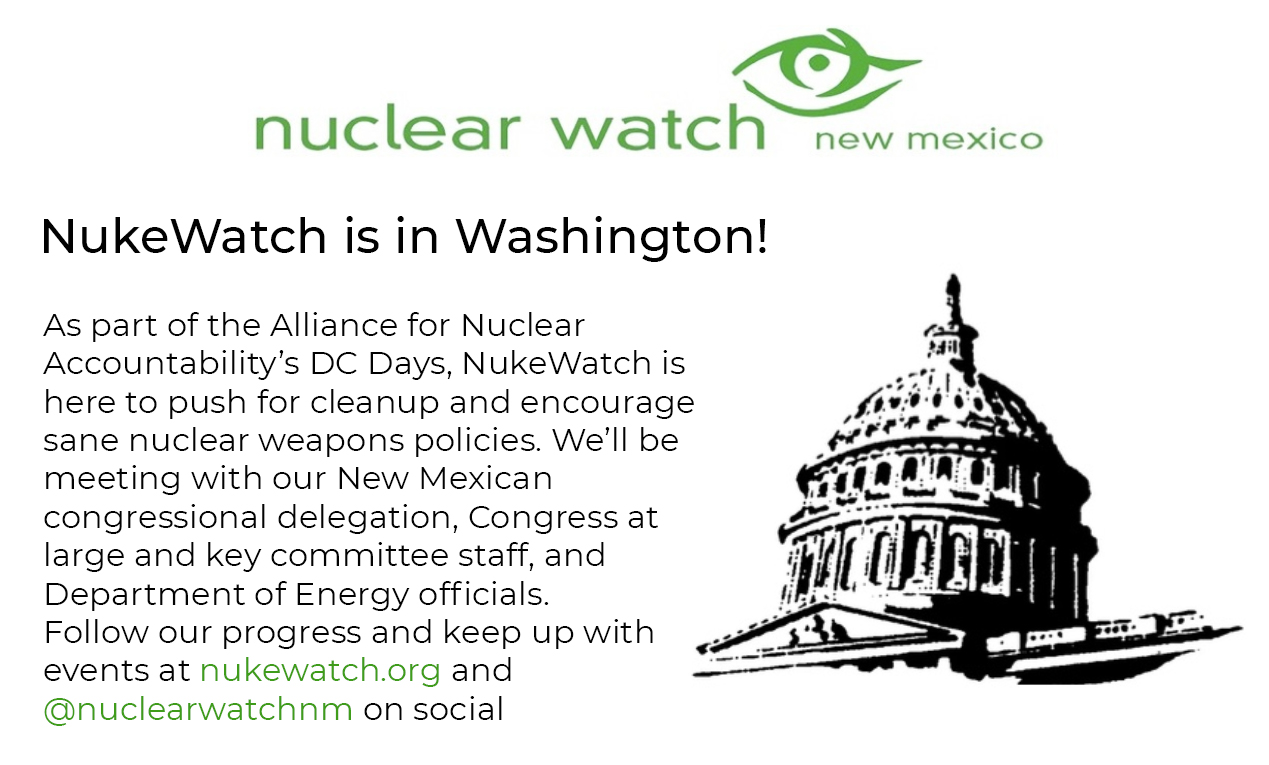 Last week, Nuclear Watch New Mexico was in Washington participating in the Alliance for Nuclear Accountability’s 31st annual DC Days. As a recent addition to the NukeWatch NM staff, this was my first time attending DC Days. The week consisted of a Sunday training day followed by three days straight of lobbying meetings with congress and other government departments that have a huge say in new nuclear weapons or energy developments. When the meeting days concluded, I also attended ANA’s Spring Meeting, which is a two-day debriefing and planning session to discuss thoughts on the week and new plans for the year ahead. This week was not only informative but enlightening, in terms of how I learned the ins-and outs of congress and the true functioning (or lack thereof, occasionally) of government. A large part of why I learned as much as I did and why I did feel so engaged, was due to being surrounded by the most genuine and helpful set of people. I would not have felt as comfortable in this world of politics (which is completely foreign to me) if it was not for the other members of ANA organizations that treated me as an equal contributor, despite my lack of knowledge in certain areas. This is a brief introduction to my time in DC, but there are more technical issues to discuss! A following post will contain the specific details of the issues ANA, and NukeWatch specifically, tackled during the week, including: Lobbying for No New Bomb Plants, Reducing proposed plutonium pit production, fighting Yucca mountain & consolidated interim storage – proposing alternatives to these, supporting a No First Use Policy, and much, much more.
Last week, Nuclear Watch New Mexico was in Washington participating in the Alliance for Nuclear Accountability’s 31st annual DC Days. As a recent addition to the NukeWatch NM staff, this was my first time attending DC Days. The week consisted of a Sunday training day followed by three days straight of lobbying meetings with congress and other government departments that have a huge say in new nuclear weapons or energy developments. When the meeting days concluded, I also attended ANA’s Spring Meeting, which is a two-day debriefing and planning session to discuss thoughts on the week and new plans for the year ahead. This week was not only informative but enlightening, in terms of how I learned the ins-and outs of congress and the true functioning (or lack thereof, occasionally) of government. A large part of why I learned as much as I did and why I did feel so engaged, was due to being surrounded by the most genuine and helpful set of people. I would not have felt as comfortable in this world of politics (which is completely foreign to me) if it was not for the other members of ANA organizations that treated me as an equal contributor, despite my lack of knowledge in certain areas. This is a brief introduction to my time in DC, but there are more technical issues to discuss! A following post will contain the specific details of the issues ANA, and NukeWatch specifically, tackled during the week, including: Lobbying for No New Bomb Plants, Reducing proposed plutonium pit production, fighting Yucca mountain & consolidated interim storage – proposing alternatives to these, supporting a No First Use Policy, and much, much more.
Parties Prepare to Start Mediation Over WIPP Waste Volume
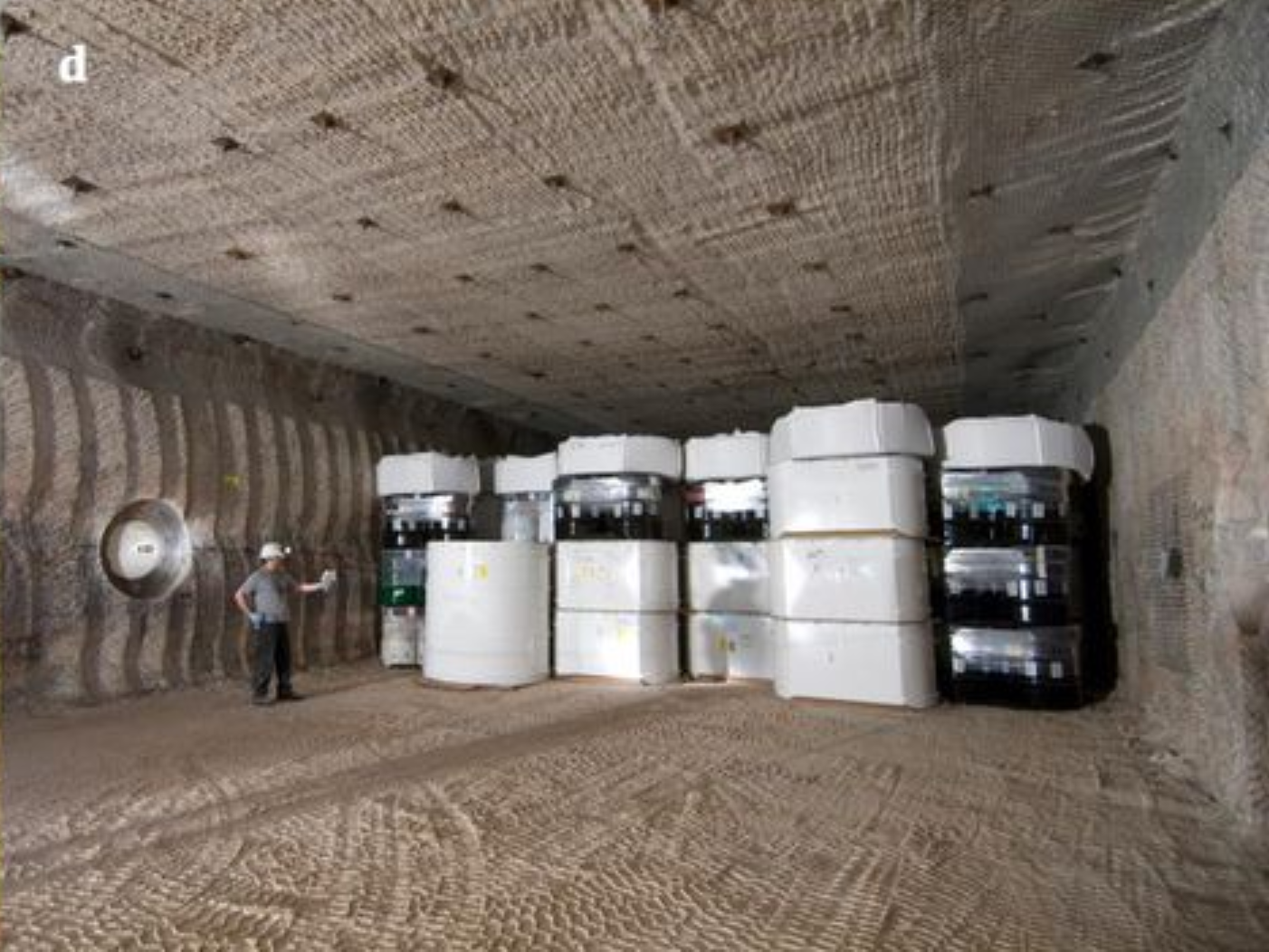
Face-to-face mediation is expected in June between public interest groups and the New Mexico Environment Department over changes to the way waste volume is calculated underground at the Energy Department’s Waste Isolation Pilot Plant (WIPP).
exchangemonitor.com | May 23, 2019
The New Mexico Court of Appeals often encourages mediation in cases involving state agencies in hopes parties can bridge their differences outside the courtroom, officials say.
A lawsuit filed in January by Nuclear Watch New Mexico and the Southwest Research and Information Center (SRIC), which challenged a change to the state hazardous waste permit for WIPP, has been stayed pending the talks.
New Mexico Court of Appeals Judge Linda Vanzi issued the stay May 2 and called for the parties to file a status report on the mediation by July 31.
The mediation itself should occur in late June, SRIC Administrator Don Hancock said by email.
Then-state Environment Department Secretary Butch Tongate in December authorized a permit modification allowing DOE to stop counting empty spaces between container drums as transuranic waste. The order adopted the findings of state hearing officer, who recommended waste volume counted against the disposal cap set by the 1992 WIPP Land Withdrawal Act should cover only the actual waste inside containers.
Study questions whether LANL, DOE can meet ‘pits’ production goal
Jay Coghlan of Nuclear Watch New Mexico said the report “makes clear that DOE is blowing smoke when it says that it will produce 80 plutonium pits per year by 2030 for new unneeded nuclear weapons. … They need to slow down, do it right and for sure do it safely. Above all the feds must concretely demonstrate a real need for expanded pit production before they fleece the American taxpayer of tens of billions of dollars.”
ARTICLE BY MARK OSWALD | abqjournal.com
SANTA FE – A recent study casts serious doubts on the potential success of any of the options considered by the U.S. Department of Energy for meeting mandates on the manufacture of plutonium cores for nuclear weapons – most of them involving Los Alamos National Laboratory.
The congressionally funded study also says that it would be “very high risk” to try to meet the nation’s ambitious goals for making bomb “pits” by installing more equipment and adding an extra work shift for a production “surge” at LANL’s existing plutonium facility, an idea that has been discussed.
Some of the risks cited in the report include whether there is the ability to stage, store and ship waste, and “the transport/transfer complexity of radioactive material.”
The study goes further and questions the overall plan to ramp up U.S. pit production, which is estimated to cost $14 billion to $28 billion, saying that “eventual success of the strategy to reconstitute plutonium pit production is far from certain.”
Continue reading
Federal workers struggle for years to prove they got sick on the job
Part 2 of NCR’s look at the toxic legacy of one nuclear weapons plant
BY CLAIRE SCHAEFFER-DUFFY | ncronline.org
The Kansas City Plant, pictured May 16, 2019, is under demolition by a private developer. The white bags in the foreground are designed to handle up to 3,000 pounds, or the equivalent of four 55-gallon drums, each of household hazardous waste. (NCR photo/Toni-Ann Ortiz)Editor’s note: As the government invests in the modernization of the U.S. nuclear arsenal, while weakening environmental regulations and federal laws protecting worker safety, National Catholic Reporter looks at the toxic legacy of one shuttered weapons plant in Kansas City, Missouri.
In a three-part series about the Kansas City Plant on Bannister Road and its successor eight miles south, NCR reviews hundreds of pages of government reports and environmental summaries, and interviews more than two dozen sources, including five plant workers and their families, three former federal employees who worked nearby, nuclear industry and government officials, health experts, business sources, state environmental regulators and a former city councilman. This is Part 2. Read Part 1 here.
If the Kansas City Plant was not a “dirty” site, then why were its workers getting sick and dying prematurely? The question haunted television reporter Russ Ptacek. In November 2009, he began investigating the Bannister Federal Complex, a 300-acre property that housed the post-war nuclear components plant as well as various federal offices leased by the General Services Administration (GSA). Ptacek began his inquiry after he was shown a list of nearly 100 sick and dying workers compiled by Barbara Rice, a retired data analyst, who worked for 31 years on the GSA side of the complex.
Nuclear Watch New Mexico & other members of the Alliance for Nuclear Accountability with Congresswoman Deb Haaland at #DCdays this evening. Thank you @RepDebHaaland for taking the time to meet with us! pic.twitter.com/vDyJmj07l9
— Nuclear Watch NM (@NuclearWatchNM) May 21, 2019
Congressman Ben Ray Lujan with Rose Gardner, Don Hancock, and Nuclear Watch NM leaders Scott Kovac & Jay Coghlan #DCDays #ANADCDays pic.twitter.com/Sbc7Ju4a2O
— Nuclear Watch NM (@NuclearWatchNM) May 21, 2019
“This report makes clear that DOE is blowing smoke when it says that it will produce 80 plutonium pits per year by 2030 for new unneeded nuclear weapons. After all, this is the gang that can’t shoot straight. They need to slow down, do it right and for sure do it safely. Above all the feds must concretely demonstrate a real need for expanded pit production before they fleece the American taxpayer of tens of billions of dollars.” — Jay Coghlan, Director – Nuclear Watch New Mexico
Frantic parents fear for kids after radioactive contamination found at Ohio middle school
“It’s so scary that my child has been exposed to this because I have no idea how it’s going to affect him,” one mother said.
BY SAFIA SAMEE ALI | nbcnews.com
Ashley Day has always worried about the health risks of living a few miles from a defunct nuclear power plant in Piketon, Ohio. So, when her son Kendon came home Monday and told her school had been canceled for the rest of the year, she had a sinking feeling there was a connection.
A few hours later, her fears were confirmed: The Scioto Valley Local School District declared in a letter that Zahn’s Corner Middle School would be shut down for the remainder of the school year because of possible radioactive contamination from the nearby Portsmouth Gaseous Diffusion Plant, which the federal Department of Energy is in the process of decommissioning.
“I felt anxiety, anger, and paranoia all at once,” she said. “It’s so scary that my child has been exposed to this because I have no idea how it’s going to affect him.”
Editorial: LANL leaders must make safety the lab’s top mission
“Falling short of the bare minimum in the eyes of the DOE is a far cry from where the public expects or needs LANL to be.”
Credit: Christopher Thompson for The New York TimesBY ALBUQUERQUE JOURNAL EDITORIAL BOARD | cnn.com
A new lab manager, a new mission to modernize the nation’s nuclear arsenal with 30 plutonium “pits” for nuclear bombs, and the same old lackadaisical approach to safety.
Welcome to Los Alamos National Laboratory, a company town where the culture is apparently so ingrained, even tough Department of Energy criticisms are unable to penetrate. At a time when saber-rattling is de rigueur, when concerns over North Korea’s arsenal and a nuclear Iran are high, when HBO is airing “Chernobyl,” that does nothing to instill public trust.
LANL got dinged last year after it mistakenly used a commercial air cargo service for a cross-country radioactive plutonium shipment. In 2014, LANL’s use of the wrong kitty litter burst a storage barrel and prompted a nearly three-year shutdown of the nation’s one-and-only nuclear waste repository, WIPP in Carlsbad. And the year before, a general slate of safety issues at the lab prompted a moratorium on plutonium work.
The latest weaknesses “if uncorrected, can allow layers of defense for nuclear safety to degrade to the extent they did leading to the pause in July 2013 of key fissile material operations in the Plutonium Facility at LANL for over four years,” the DOE audit says.
And that is a huge issue considering the lab is ramping up production on the devices that act as nuclear bomb triggers. The 30-pit order is expected to be met in six years, and there’s no other facility in the country that can fill it.
Ohio town worries about safety after radioactive contamination is found at middle school
On Monday, Zahn’s Corner Middle School in Piketon was closed because enriched uranium had been detected inside the building and neptunium-237 had been detected by an air monitor next to it.
BY CHUCK JOHNSON & SUSAN SCUTTI | cnn.com
(CNN) Are we safe? That’s the concern that’s been in the back of neighbors’ minds when they look at the looming Portsmouth Gaseous Diffusion Plant in Pike County, Ohio, Jennifer Chandler said.
“It looks like they make clouds there,” the Piketon village councilwoman thought as a child, seeing steam coming out of the stacks. “When I was growing up, I didn’t have any idea what they did.”
The US Department of Energy plant was built to produce enriched uranium for the nation’s nuclear weapons program during the Cold War and, in later years, supported commercial nuclear reactors. One of three such plants in the United States, it operated from 1954 to 2001, when it commenced decontamination and decommissioning, which continues today.
In the past five years, five students in the nearby Scioto Valley Local School District have been diagnosed with cancer; three of them have died, Chandler said.
2019 Preparatory Meeting for 2020 Nonproliferation Treaty Review Conference Ends in Failure
NPT Looks Ahead to 2020 Review Conference Without Consensus Recommendations
BY ALICIA SANDERS-ZAKRE | armscontrol.org
NPT states-parties failed to adopt a common set of recommendations for the 2020 Review Conference on the final day of the two week-long 2019 PrepCom on Friday, May 10. Nevertheless, most states expressed optimism in concluding statements about prospects for next year’s review conference and underlined the importance of action in the intervening 12 months on key NPT-related commitments.
The recommendations drafted by the chair, Syed Hussin of Malaysia, failed to garner consensus especially after a round of revisions that sought to take into account the suggestions of the majority of NPT states-parties led several nuclear-weapon states and some of their allies to express their displeasure and their support for the earlier draft. Since NPT states did not adopt the revised draft recommendations by consensus, the document will be issued instead as a working paper submitted by the PrepCom chair. The chair also issued an 8-paragraph reflection on the PrepCom.
In his closing remarks, the incoming president-designate of the 2020 Review Conference, Rafael Mariono Grossi of Argentina promised to “begin work on Monday” on an ambitious plan for consultations with states-parties.
He later tweeted: “As #NPT2019 closes work starts to prepare a successful Review of Non-Proliferation Treaty in 2020. I will consult extensively reach out to all. Everybody’s goal is success. No less.
As #NPT2019 closes work starts to prepare a successful Review of Non Proliferation Treaty in 2020. I will consult extensively reach out to all. Everybody’s goal is success. No less. @UN_Disarmament @CancilleriaARG @ArmsControlNow @NTI_WMD pic.twitter.com/pbaWHq2rsN
— Rafael MarianoGrossi (@rafaelmgrossi) May 10, 2019
Balky Capacitors Could Delay Two NNSA Nuke Refurb Programs
BY DAN LEONE | exchangemonitor.com
WASHINGTON — The National Nuclear Security Administration (NNSA) will be late with initial deliveries to the Pentagon of two refurbished nuclear weapons, the head of the semiautonomous nuclear-weapons agency said here Wednesday.
The Air Force was supposed to get its refurbished B61, to be called B61-12, in 2020. The Navy was supposed to get its first W88 Alt 370 in December 2019. Because of defects with electrical capacitors needed for both weapons, those those dates are now “expected” to slip, an NNSA spokesperson said. How far is yet to be determined.
After disclosing the slip in a hearing of the Senate Armed Services strategic forces subcommittee, NNSA Administrator Lisa Gordon-Hagerty told Weapons Complex Morning Briefing that her agency has been evaluating the bad capacitors for “the last couple of months.”
Capacitors store electric charges. The defective items intended for the B61-12 and W88 Alt 370 are commercial units procured by the NNSA’s Kansas City National Security Campus, which acquires and manufactures the non-nuclear parts of nuclear weapons. Gordon-Hagerty said it will take several months to decide what to do about the wonky components.
Continue reading
Support the JASON science-advisory group
The elite panel that guides the US government is undermined by wavering financial support. More-secure backing is in the national interest.
The Jasons have provided the US government with independent advice on classified military developments and nuclear weapons. Credit: Ringo Chiu/AFP/Gettynature.com | If there is one thing that President Donald Trump’s administration sorely needs, it is rational, independent science-based advice on crucial issues. Which is why it was so concerning when the US Department of Defense (DOD) abruptly decided in March to end its long relationship with a science-advisory panel known as JASON.
For nearly 60 years, the scientists on the panel — the Jasons — have provided the US government with unvarnished, independent advice on matters ranging from classified military developments and nuclear weapons to artificial intelligence and global warming. Its members are a roll call of elite and illustrious scientists.
Federal nuclear board nixes request for hearing on New Mexico waste facility
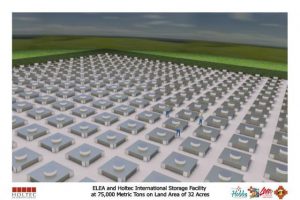
By Rebecca Moss | rmoss@sfnewmexican.com
A federal board that oversees commercial nuclear materials and licenses said Tuesday it has rejected a request by a group of opponents over a proposed nuclear waste storage site in Southern New Mexico.
Holtec International, a New Jersey-based company specializing in nuclear reactor technology, is waiting on the U.S. Nuclear Regulatory Commission to approve its license for an expansive facility that could be used to hold all of the nation’s spent nuclear fuel — radioactive uranium left over from power production.
Engel, McCaul Introduce Legislation to Maintain Limits on Russian Nuclear Forces
 WASHINGTON—Representative Eliot L. Engel, Chairman of the House Committee on Foreign Affairs, and Representative Michael McCaul, the Committee’s ranking member, today introduced legislation calling on the Trump Administration to retain limits on Russia’s nuclear forces. The “Richard G. Lugar and Ellen O. Tauscher Act to Maintain Limits on Russian Nuclear Forces” calls for an extension of New Strategic Arms Reduction Treaty (New START) limits on Russia until 2026, as allowed under the Treaty, unless Russia violates the Treaty or until a new agreement in is in place that provides equal or greater constraints, transparency, and verification measures with regard to Russia’s nuclear forces.
WASHINGTON—Representative Eliot L. Engel, Chairman of the House Committee on Foreign Affairs, and Representative Michael McCaul, the Committee’s ranking member, today introduced legislation calling on the Trump Administration to retain limits on Russia’s nuclear forces. The “Richard G. Lugar and Ellen O. Tauscher Act to Maintain Limits on Russian Nuclear Forces” calls for an extension of New Strategic Arms Reduction Treaty (New START) limits on Russia until 2026, as allowed under the Treaty, unless Russia violates the Treaty or until a new agreement in is in place that provides equal or greater constraints, transparency, and verification measures with regard to Russia’s nuclear forces.
The U.S. Wanted to Hide Nukes in Arctic Ice Tunnels. The Plan Blew Up in Their Faces.
BY VINCE HOUGHTON | time.com May 7, 2019
As far as these things go, Camp Century was a pretty good cover. It was nominally designed as an underground military research station, located about 150 miles east of the American air base at Thule, Greenland. The stated purpose of Camp Century was to improve the American defense capability in the Arctic — to develop better survival and transportation techniques, and to obtain more useful knowledge about the harsh climate and the physical properties of the region. In essence, we covered up for a super-secret operation using a kinda-secret one.
Producing mass destruction: Private companies and the nuclear weapons industry
ICAN and PAX published a new report that shows how the commercial sector is massively involved in producing nuclear weapons. The report, “Producing mass destruction: Private companies and the nuclear weapons industry”, is part of the Don’t Bank on the Bomb project.
EXECUTIVE SUMMARY | dontbankonthebomb.com
FULL REPORT AVAILABLE HERE
 Governments are contracting at least US$ 116 billion (€ 102 billion) to private companies in France, India, Italy, the Netherlands, United Kingdom, and the United States for production, development and stockpiling of nuclear weapons. State owned companies in China connected to nuclear weapon production are starting to raise money through bond issuances, while Israeli, Pakistani, North Korean, and Russian nuclear programmes are still not transparent.
Governments are contracting at least US$ 116 billion (€ 102 billion) to private companies in France, India, Italy, the Netherlands, United Kingdom, and the United States for production, development and stockpiling of nuclear weapons. State owned companies in China connected to nuclear weapon production are starting to raise money through bond issuances, while Israeli, Pakistani, North Korean, and Russian nuclear programmes are still not transparent.
Nuclear News Archives – 2021
Nothing Found
It seems we can’t find what you’re looking for. Perhaps searching can help.
Nuclear News Archives – 2020
Nothing Found
It seems we can’t find what you’re looking for. Perhaps searching can help.
Nuclear News Archives – 2019
Nothing Found
It seems we can’t find what you’re looking for. Perhaps searching can help.
Nuclear News Archives – 2018
Nothing Found
It seems we can’t find what you’re looking for. Perhaps searching can help.

